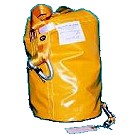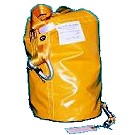Spherachutes Anchor -Formally Para-Tech Sea Anchor - 9 foot Diameter - PTS09
Spherachutes Anchor -Formally Para-Tech Sea Anchor - 9 foot Diameter - PTS09
SKU:PTS09
Couldn't load pickup availability
Share

Spherachutes Anchor -Formally Para-Tech Sea Anchor - 9 foot Diameter - PTS09
"A Sea-Anchor belongs there, right next to your life raft, EPIRB and survival suit: USE IT, as your FIRST line of defense in heavy weather, SO YOU WON'T HAVE TO USE YOUR life raft, EPIRB or survival suit..."
PARA-TECH Sea Anchor
Also known as the PARA-ANCHOR or parachute anchor.
No small, independent craft should venture offshore without the tremendous confidence and security afforded by a PARA-TECH Sea Anchor. PARA-TECH Engineering Co. is committed to your safety and wellbeing when cruising offshore. Read what Sea Anchor users have to say. These are excerpts directly from the Drag Device Database by Victor Shane:
"We’re alive! Thanks to the parachute [Sea] anchor which secured us for 53 hours in Cyclone Justin..."
"The sea anchor definitely saved the boat and I’m sure our lives. It operated flawlessly on those two days [985mb storm] and the other three days during the other two gales ... We did what should have been done and came through a very violent storm and survived with no damage. Thank you again for everything."
"My parachute [Sea Anchor] is one of the few items I purchased which performed as advertised and no defect or surprises. I appreciated the quality and performance more than I can express. Wouldn’t leave port without it, ever!"
"... I consider your equipment the most important safety item on my boat ... I will never make an ocean passage without one on board. People must realize that ocean cruising can be safe if you go with the idea that you will go into a defensive position before the seas build too high...”
“Commercial fishermen have been using parachutes at sea for decades ... on long excursions the parachute is indispensable for sea layovers, for heaving to and for otherwise maintaining station on fishing grounds. With the engine shut off, drift is reduced up to 90% with the bow pointed comfortably into the seas ...other vessels went into port with broken trips ... we stayed, and in this respect the [Sea] anchor paid for itself."
PARA-TECH Sea Anchor Advantages
Self-Sufficiency: Good seamanship is the essence of preparedness. That’s why no small, independent craft should venture offshore without the tremendous confidence, security, insurance, and peace of mind afforded by a PARA-TECH Sea Anchor. A Sea Anchor will go a long way toward enabling a skipper to limit contingencies at sea and dispose of them early. Self-sufficiency is the trend of the day and a Sea Anchor will contribute greatly to self-sufficiency on the often hostile interface between sea and sky, with all the uncertainties – and challenges – that they hold for the contemporary sailor.
Safety Valve At Sea: For shorthanded sailors, hopeless exhaustion is just as dangerous as the sudden gale. Brain-numb from fatigue, the shorthanded sailor will soon cross the dangerous threshold beyond which all is error and wrong decision. It is precisely at this point that a Sea Anchor is worth its weight in gold. Set the Sea Anchor, get some rest, and then get up to fight again, with your brain back in working order.
"Precious Miles:" Sometimes it doesn’t pay to beat into heavy seas. The wear and tear on the crew and boat do not justify the handful of miles gained upwind. It may be wiser to lay-to a Sea Anchor and wait for better conditions. To heave-to without one may mean losing in a few hours what you have spent days gaining.
Drift Control: Many boats are lost annually when – initially disabled – they drift out of control and run aground. A Sea Anchor will enable you to hold your position and keep your boat off the rocks long enough for help to arrive.
Attitude Stabilization: With sails down or engine out, your boat will become unstable, rolling sickeningly, rails buried in the troughs. A Sea Anchor will force the bow back into the seas and restore stability, allowing you to go about the business of pumping out, making repairs, or going up the mast if necessary.
Making Landfall Safely: To quote Webb Chiles: "Land is a mixed blessing." Lord knows how many boats have arrived at night and gone belly-up on reefs because the skipper couldn’t wait set foot on dry land. If you make the landfall at night and the entry is a difficult one, lay off a safe distance and lay-to your Sea Anchor until daybreak. Better late than never.
Multihulls: U.S. Sailing has recognized the value of Sea Anchor use aboard multihulls in Appendix VII of ‘Recommendations for Offshore Sailing." One multihull builder has stated that the introduction of large diameter parachute type Sea Anchors has made it safer for multihulls to cruise blue water.
Design & Construction
PARA-TECH Sea Anchors are made from high-strength nylon fabric, possessing a weight and strength more than four times that of surplus parachutes, which have been used as Sea Anchors for many years. The seams are reinforced with nylon webbing. Nylon lines with a minimum strength of 1,500 pounds are joined at the rode end to a shackle with strength from 17,000 to 52,000 pounds A correctly-sized PARA-TECH Sea Anchor will likely never experience the loads it is capable of taking.
PARA-TECH Sea Anchors are designed to be failure-tolerant. If the full system is over-stressed, the Sea Anchor is designed to blow a panel before anything else fails. The Sea Anchor will still hold the boat, but with increased drift. It will function properly even with some broken or damaged lines.
When PARA-TECH entered the Sea Anchor business more than 35 years ago, we supplied surplus personnel parachutes to the sport fishing industry in San Diego, California. Those parachutes failed within one season, which prompted us to make our own durable Sea Anchors. By contrast, in 1996, we received a 5-year old PARA-TECH Sea Anchor which was worn out. The skipper reported that it had spent the equivalent of one year in the water.

User Friendly
PARA-TECH Sea Anchors are the easiest sea anchors in the world to use. Thanks to input from the Drag Device Database by Victor Shane, we added our Deployable Stow Bag, which eliminates the tendency for a parachute Sea Anchor to "catch air" and inflate on deck, making deployment difficult at best. The bag is simply tossed overboard with the Sea Anchor inside. The Sea Anchor automatically deploys in the water from the bag, safe from the effects of the raging wind. All PARA-TECH system components are likewise designed for ease of use and clean deployment. We are constantly looking for ways to improve all of our products.
Rigging, Rode & Deployment
Sea Anchor Rigging: All components used with your Sea Anchor must be suitable for storm anchoring and bow attachments (cleats, Sampson posts, etc.) and have backing plates. The rode must be nylon and 10 to 15 times the boat’s overall length in heavy weather. A stainless steel swivel is highly recommended. Multi-hulls also must rig the rode to a bridle with each leg being 2-2½ times the beam of the boat and rigged to the outer hulls. A partial trip line is the simplest way to retrieve your Sea Anchor.
Payout Lots of Rode: The Sea Anchor relies very heavily on the stretch of the long nylon rode for yielding to the seas (and not standing up to them). In moderate conditions you can expect a payout of as much as 300 feet or more of rode, or 10 to 15 times the boat’s overall length in heavy weather situations.
Sea Anchor Deployment Steps
- Secure items on board, lower sails, etc.
- Head into the weather to "stall" the boat.
- Toss the trip line, float line and Sea Anchor into the water on the windward side of the boat, followed by the rode.
- Drift back on the Sea Anchor, paying out the required scope.
- Make fast the rode and employ chafe gear.
- Secure the rudder amidships.
- Secure the boat and get some rest.
Specifications & Sizing Guidelines
Sizing is first based on length overall with weight, keel configuration and windage taken into account next. Note that generally the greater windage of power boats equals the greater draft (wetted surface) of sailing craft, hence the same size “Sea Anchor.” When in doubt, go to the larger size. General recommendations are as follows:
| Boat LOA | Displacement | Sea Anchor Size | Packed Dimensions | Weight |
|---|---|---|---|---|
| Under 20 ft. | Under 4,000 lbs. | 6 Foot | 8" Dia. X 8" Tall | 6 lbs. |
| Under 25 ft. | Under 8,000 lbs | 9 Foot | 8" Dia. X 10" Tall | 9 lbs. |
| 25 to 33 ft. | Under 12,000 lbs. | 12 Foot | 10" Dia. X 14" Tall | 12 lbs. |
| 30 to 40 ft. | Under 25,000 lbs. | 15 Foot | 11" Dia X 16" Tall | 20 lbs. |
| 35 to 48 ft. | Under 40,000 lbs. | 18 Foot | 12" Dia X 18" Tall | 25 lbs. |
| 40 to 90 ft. | Under 95,000 lbs. | 24 Foot | 13" Dia. X 19" Tall | 35 lbs. |
| 70 to 120 ft. | Under 200,000 lbs. | 32 Foot | 16" Dia. X 25" Tall | 55 lbs. |
| 120 to 150 ft. | Under 300,000 lbs. | 40 Foot | 18" Dia. X 30" Tall | 110 lbs. |
Included with All PARA-TECH Sea Anchors:
- Deployable Stowage Bag
- Heavy Duty Shackle
- Float Line
- Instruction Manual
Not Included:
- Floats
- Anchor Rode
- Swivel Shackle
- Boat (We’re really cheap about this.)
Fishing Applications
Overnight Layovers: When on multi-day trips sport fishermen (and commercial fishermen) will lay on a Sea Anchor rather than jog into the seas. This technique saves fuel, provides for a comfortable, stable ride and allows the crew to rest.
Storm Use: When the seas get rough and there is a risk of broaching, laying to a Sea Anchor forces the bow into the seas where the boat is less vulnerable as boats are designed to penetrate the seas bow first. This is the most recognized Sea Anchor application for all offshore boats.
Drift Control: When fishing in windy conditions it is difficult to stay on station and not roll in the trough without jogging into the seas. Using a Sea Anchor reduces drift to a minimal amount and keeps the boat on top of the desired fishing grounds.
Kite Fishing: Kite fishing is done in windy conditions. In such conditions, a boat drifts too fast to effect a good bait presentation or to stay with the chum. A Sea Anchor will hold the boat on top of the fishing grounds for a longer period and improve the chances of good strikes. Some boat owners who kite fish carry more than one Sea Anchor, sometimes using the smaller one and at other times using the bigger one, in order to drift at a rate that will give them the best bait presentation.
Emergencies: In the event of engine power loss, using a Sea Anchor will point the bow into the seas keeping the boat from rolling in the trough, thus making repairs easier. The boat is also held in its last reported position, making it easier for assistance to find the disabled boat.
Additional Rode, Swivel, Chain and Retrieval Line are necessary to use the Para-Tech Sea-Anchor. These items can be purchased at you local chandlery. Instructions are included with each Sea-Anchor.

